
William Clark Gable was an American film actor. Often referred to as the "King of Hollywood", he had roles in more than 60 films in a variety of genres during a career that lasted 37 years, three decades of which was as a leading man. He was named the seventh greatest male movie star of classic American cinema by the American Film Institute.

Test Pilot is a 1938 American drama film directed by Victor Fleming, starring Clark Gable, Myrna Loy and Spencer Tracy, and featuring Lionel Barrymore. The Oscar-nominated film tells the story of a daredevil test pilot (Gable), his wife (Loy), and his best friend (Tracy).

Antoine Marie Jean-Baptiste Roger, comte de Saint-Exupéry, known simply as Antoine de Saint-Exupéry, was a French writer, poet, journalist and aviator. He received several prestigious literary awards for his novella The Little Prince and for his lyrical aviation writings, including Wind, Sand and Stars and Night Flight. His works have been translated into many languages.

The Little Prince is a novella written and illustrated by French writer, and military pilot, Antoine de Saint-Exupéry. It was first published in English and French in the United States by Reynal & Hitchcock in April 1943 and was published posthumously in France following liberation; Saint-Exupéry's works had been banned by the Vichy Regime. The story follows a young prince who visits various planets, including Earth, and addresses themes of loneliness, friendship, love, and loss. Despite its style as a children's book, The Little Prince makes observations about life, adults, and human nature.
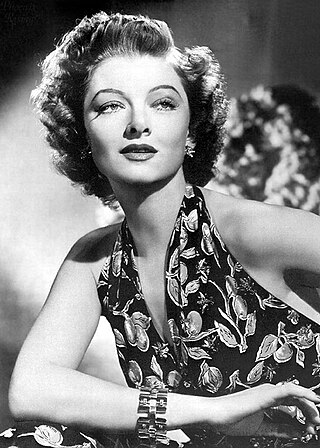
Myrna Loy was an American film, television and stage actress. As a performer, she was known for her ability to adapt to her screen partner's acting style.

Manhattan Melodrama is a 1934 American pre-Code crime drama film, produced by MGM, directed by W. S. Van Dyke, and starring Clark Gable, William Powell, and Myrna Loy. The movie also provided one of Mickey Rooney's earliest film roles. The film is based on a story by Arthur Caesar, who won the Academy Award for Best Original Story. It was also the first of Myrna Loy and William Powell's fourteen screen pairings.
Volo di notte is a one-act opera composed by Luigi Dallapiccola to an Italian libretto he wrote based on the novel Vol de nuit by Antoine de Saint-Exupéry. It was first performed at the Teatro della Pergola in Florence on May 18, 1940.
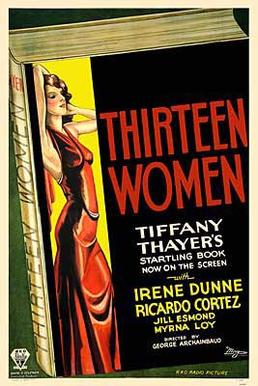
Thirteen Women is a 1932 American pre-Code psychological thriller film, produced by David O. Selznick and directed by George Archainbaud. It stars Myrna Loy, Irene Dunne and Ricardo Cortez. The film is based on the 1930 bestselling novel of the same name by Tiffany Thayer and was adapted for the screen by Bartlett Cormack and Samuel Ornitz.

The Little Prince is a 1974 British-American sci-fi fantasy-musical film with screenplay and lyrics by Alan Jay Lerner, music by Frederick Loewe, arranged and orchestrated by Angela Morley. It was both directed and produced by Stanley Donen and based on the 1943 classic children-adult's novella, The Little Prince, by the writer, poet and aviator Count Antoine de Saint-Exupéry, who disappeared near the end of the Second World War some 15 months after his fable was first published.

Aéropostale was a pioneering aviation company which operated from 1918 to 1933. It was founded in 1918 in Toulouse, France, as Société des lignes Latécoère, also known as Lignes aeriennes Latécoère or simply "The Line".

Wife vs. Secretary is a 1936 American romantic comedy drama film starring Clark Gable, Myrna Loy and Jean Harlow. Directed and co-produced by Clarence Brown, it was the fifth of six collaborations between Gable and Harlow and the fourth of seven between Gable and Loy. The screenplay was based on the short story of the same title by Faith Baldwin, published in Cosmopolitan magazine in May 1935. The screenplay was written by Norman Krasna, John Lee Mahin and Alice Duer Miller.

Topaze is a 1933 American pre-Code film directed by D'Abbadie D'Arrast and starring John Barrymore and Myrna Loy. It was based on the 1928 French play of the same name by Marcel Pagnol. Another film version of Topaze, this one made in the original French was also released that year, starring Louis Jouvet in the title role. Subsequently, Pagnol himself directed another film titled Topaze in 1936.
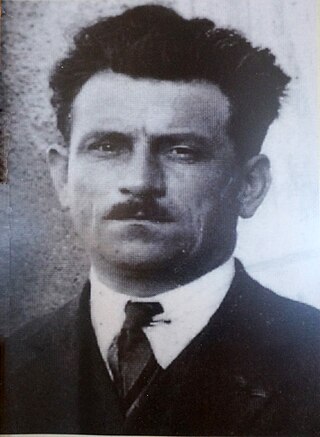
Didier Daurat was a pioneer of French aviation. He was a fighter pilot during World War I, distinguishing himself by spotting the Paris Gun which was pounding Paris. After the war, he joined an airline company, which later became the Compagnie générale aéropostale - Aéropostale, then Air France, where he was a pilot and later operations director.
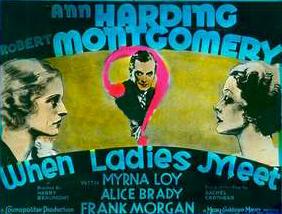
When Ladies Meet is a 1933 American pre-Code comedy film directed by Harry Beaumont and starring Ann Harding, Myrna Loy, Robert Montgomery, Alice Brady, and Frank Morgan. The film is the first adaptation of the 1932 Rachel Crothers play of the same name. It was nominated for an Academy Award for Best Art Direction by Cedric Gibbons.

Hold Your Man is a 1933 American pre-Code romantic drama film directed by an uncredited Sam Wood and starring Jean Harlow and Clark Gable, the third of their six films together. The screenplay by Anita Loos and Howard Emmett Rogers was based on a story by Loos.
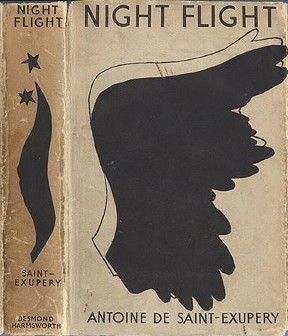
Night Flight, published as Vol de Nuit in 1931, was the second novel by French writer and aviator Antoine de Saint-Exupéry. It went on to become an international bestseller and a film based on it appeared in 1933. Its popularity, which only grew with the ideological conflicts of the 1930s and 1940s, was due to its master theme of sacrificing personal considerations to a cause in which one believes.

Parnell is a 1937 American biographical film produced by Metro-Goldwyn-Mayer, starring Clark Gable as Charles Stewart Parnell, the famous Irish politician. It was Gable's least successful film and is generally considered his worst, and it is listed in The Fifty Worst Films of All Time. The movie addresses the sex scandal that destroyed Parnell's political career, but its treatment of the subject is highly sanitized in keeping with Hollywood content restrictions at the time.

Too Hot to Handle, also known as Let 'Em All Talk, is a 1938 comedy-drama directed by Jack Conway and starring Clark Gable, Myrna Loy, and Walter Pidgeon. The plot concerns a newsreel reporter, the female aviator he is attracted to and his fierce competitor. Many of the comedy gags were devised by an uncredited Buster Keaton.
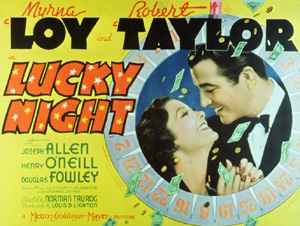
Lucky Night (1939) is a comedy movie from MGM starring Robert Taylor and Myrna Loy, directed by Norman Taurog.


















